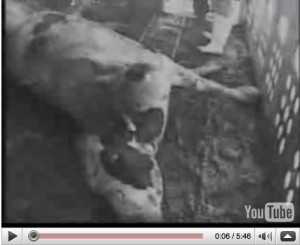The use of closed circuit television or some form of video surveillance is increasingly being used to monitor animal welfare procedures at slaughterhouses – who wants to be held hostage by the last plant hire who may be recording stuff for an activist group – and is starting to be used to enhance food safety techniques.
Australia has a significant business involving life animal export for overseas slaughter.
The Brisbane Times reports that People for the Ethical Treatment of Animals has written to the Australian Livestock Exporters Council offering to pay for cameras on export boats and  approved international slaughterhouses in a bid to stamp out cruelty.
approved international slaughterhouses in a bid to stamp out cruelty.
The trade has been plagued by frequent revelations of inhumane treatment of animals.
The group’s director of campaigns, Jason Baker, wrote to the livestock council chief executive Alison Penfold with the offer to ”pay to install and monitor surveillance cameras on each ship that transports animals from Australia to be slaughtered overseas as well as in all the slaughterhouses approved by the Exporter Supply Chain Assurance System’.’
Under the plan the footage would be available on the Internet on a live stream. He said video would also make it easier to identify and attend to animals that become sick or injured on board the ships.
”If there is nothing to hide, why not let the public see what life is like for animals on live-export ships?” Mr Baker wrote.
Ms Penfold said the matter was one for individual export supply chain participants. She said a focus on training and support was ”the best investment to changing practices and behaviors towards livestock and will deliver lasting improvements to animal welfare outcomes.”
 Ian Brock, 31, was caught on CCTV pulling his trousers down and defecating in a corner.
Ian Brock, 31, was caught on CCTV pulling his trousers down and defecating in a corner.
